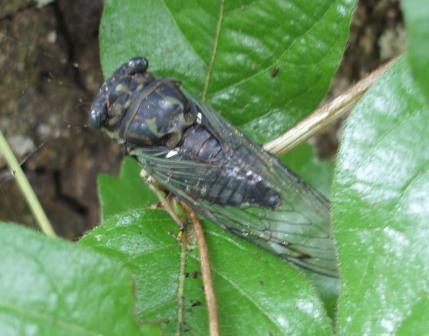by Carl Strang
One of the obstacles to a singing insect monitoring program is the large number of various songs that need to be learned for identification. This is not really much different from learning bird songs for breeding bird monitoring, however (except that the total number of species is smaller here). Instead of being daunted by the entire process, it is possible to take the learning process in stages, beginning with the songs that are common and easy to recognize, the ones you have been hearing all along but simply didn’t have the species labels. Here is a list of a dozen suggested species to start with in the first stage: spring field cricket/fall field cricket (their songs are identical), Allard’s and striped ground crickets, snowy tree cricket, common true katydid, black-legged meadow katydid, greater angle-wing, round-tipped conehead, dog day cicada, scissor-grinder cicada, and Linne’s cicada (for more information on these species, try the tags at the head of this post).

Snowy tree cricket, one of the species on the starter list
This list and those that will follow are for northeastern Illinois and northwestern Indiana. There would be substitutions in other parts of the country (I encourage readers elsewhere to make comments here with their own suggestions). Go to reference recordings of these species’ songs, either on-line at the Singing Insects of North America website or through the CD that accompanies the Songs of Insects book. It is not too late this year to hear many of the species on this list on the warmer days, though some are finished or nearly so.
My recommended species list to focus on in the second stage of learning consists of 8 species and groups of species: greenstriped grasshopper, gladiator meadow katydid, Roesel’s katydid ( three species that sing relatively early in the season), and then later, Carolina ground cricket, Say’s trig, sword-bearing conehead, two-spotted/narrow-winged tree crickets (no need to worry yet about separating the two), and the meadow tree cricket group (3-4 species whose songs are essentially identical to the ear and will remain so).

Roesel’s katydid is a species from the second-stage list.
This list of common species either will take you to additional, though still readily available, habitats, or else require a little more of a practiced ear (which practice you got with the first species group). In particular, seek out and spend some time getting familiar with the songs of the Carolina ground cricket and Say’s trig. They need a little more effort to recognize in the field, but once you have them, they will be touchstones for many other species (much as robin songs are for learning bird vocalizations). If you are starting now, you might push the Carolina ground cricket to the first list, as it is one of the few species singing on the cooler days and evenings.
Once you have mastered the second list of species, you are ready for the more subtle distinctions needed to distinguish the songs in the third species list. This includes separating out the song of Linne’s cicada from similar songs by the lyric cicada, and in some areas, swamp and/or northern dusk-singing cicada.

Linne’s cicada
Also, by this point you are ready to distinguish the two-spotted tree cricket song from that of the narrow-winged tree cricket. Also, the broad-winged tree cricket should stand out now from other long-trilling species. In addition, you no doubt have noticed and begun to puzzle out other species that are more idiosyncratic in their distribution or smaller in numbers that you have encountered in your favorite places.
And that brings you to the fourth stage, learning the songs of whatever remaining species may live in the area you wish to monitor. For this you will need a regional guide. In the Chicago region, you can meet this need with the guide I am developing. It is available for free as a .pdf e-mail attachment. Simply request it at my work e-mail address: cstrang@dupageforest.com
As you are learning and listening, pay attention to which songs you can hear clearly, and at what distances, and which are marginal. This will inform the limitations you will need to address or acknowledge in your monitoring.












